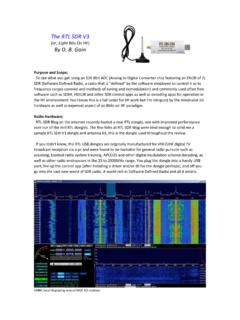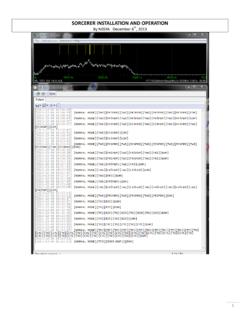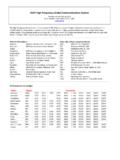Transcription of UDXF UTILITY Dxers FORUM ELF and VLF Guide …
1 udxf UTILITY Dxers FORUM ELF and VLF Guide Version - updated 15 November 2001 The target of focus for this ELF and VLF Guide , is manmade signals in the range from DC to 30 kHz. For the multitude of natural signals, in the ELF and VLF range of the electromagnetic spectrum, go to the link section at the end of this paper. CONTENT OF THIS ELF AND VLF Guide * FORMAT FOR THIS ELF AND VLF Guide * LIST OF RADIO-SIGNALS: RADIO-SIGNALS BELOW 10 kHz RADIO-SIGNALS IN THE RANGE; 10 15 kHz RADIO-SIGNALS IN THE RANGE; 15 20 kHz RADIO-SIGNALS IN THE RANGE; 20 25 kHz RADIO-SIGNALS IN THE RANGE; 25 30 kHz * LIST OF CALL-SIGNS AND THEIR LOCATIONS * THE BACKGROUND FOR THIS ELF and VLF Guide * A SOFT RECEIVER FOR VLF USE, with update.
2 * LINKS TOWARDS FURTHER INFO FORMAT FOR THIS ELF AND VLF Guide FREQUENCY:CALLSIGN or ID:STATION and LOCATION:MODE STATUS: DETAILS: When mode is not known or unidentified, it is listed as: unid Example :VTX3:INS Katabomman, South Vijayanarayanam village,INDIA:A1A,MSK ACTIVE The transmitter site is ( just opposite the Indian Naval Station Katabomman ) at South Vijayanarayanam ( Vijaya N r yanam ) village, 8 25' "N 77 48'00"E, reported as some 30 km's from Turunelveli on the Kanyakumari highway. In some lists VTX3 is incorrectly located at Vishakapatnam Radio, the HQ of the Indian Coast Guard, East Coast has been monitored using very high speed A1A, morse.
3 LIST OF RADIO-SIGNALS RADIO-SIGNALS; BELOW 10 kHz :unid/none:unid:N0N ACTIVE Presumed, but not yet verified as a man-made signal. Detected at various locations worldwide. With amateur equipment, it is not easy to determine eventual frequency shifts, so signal is listed as a Hz carrier. So far the signal is not connected with any known geophysical events. Most likely not originating from HAARP - Gakona in Alaska USA. They have little success, with the generation of ELF signals of reasonable strength, over anything then relative short distances. - :unid/none:experimental ULF transmitter, Kola peninsula, Russia:(N0N/P0N ?)
4 ACTIVE, but no recent info Designed and operated by RIPR (Russian Institute of Powerful Radio- structures)in St. Petersburg, Russia. As the Russians call it; the first "easy flexible ULF facility for geophysical applications" As a feedline for the grounded dipol antenna, is used a 108 km lenght of a HV powerline, owned by Kola Peninsula Powerline Company. The HV line goes from their hydroelectric powerplant, near Serbryansky at the Varonya river, to Kola-Kildinstroy south of Murmansk. The portable 50 kW transmitter supplies 60-100 A in the line at these frequencies; - 12 Hz band, 2-3 Hz band, and single frequency tests at 4, 8, 10 and 12 Hz.
5 :unid:US NAVY ELF communication facility, Republic Michigan, USA:MSK :unid:US NAVY ELF communication facility, Clam Lake Wisconsin, USA:MSK BOTH ACTIVE 76 Hz center frequency, 4Hz shift, 80 Hz for "1", 72 Hz for"0". For maximum signal coverage, the two stations operate simultaneously. Secondary frequency is reported as kHz. Other operational frequencies are technically possible, but so far not reported. The special - AC deep grounding system, in use for the ELF antenna, was designed and installed by LORESCO International. The boreholes for the deep grounding system is km (2 US miles) deep.
6 The US Navy ELF transmitter facilities are believed to have a input power of 3 MW. As the efficiency of the antenna system is rather low, the predicted ERP is only 3 Watt (!). :unid:Russian Navy ELF communication facility, Kola Peninsula, RUSSIA:MSK ACTIVE Transmission format: 82 Hz N0N and (multichannel ? )MSK. Prior to message is a supposed "bellringer" or message follows signal: Hz shift down to Hz for 8 minutes, then up to Hz for 4 minutes. This initial sequence, is directly followed by a downshift to 81 Hz for 38 seconds and a upshift to Hz for 22 seconds. After this comes the message, using these shifts, for a total of 16 minutes.
7 A complete message sequence last for 29 minutes. "Zevs" is reported to have an operational frequency range of to kHz. This Russian ELF transmitter is nicknamed ZEVS . RADIOSIGNALS IN THE RANGE; 10 - 15 kHz :none:RSDN-20 F1, masterstation Novosibirsk 55N84E26 RUSSIA:P0N ACTIVE Russian hyperbolic radionavigation system RSDN-20(Radioteknicheskaya Systema Dalyokoiy Navigatsii) Exact location: 55:45 N 84:26 E. The Russian RSDN-20 stations are nicknamed ALPHA :none:RSDN-20 F1, Krasnodar, 45N24 38E09, RUSSIA:P0N ACTIVE Russian hyperbolic radionavigation system RSDN-20(Radioteknicheskaya Systema Dalyokoiy Navigatsii) Exact location: 45:24 N 38:09 E.
8 The Russian RSDN-20 stations are nicknamed ALPHA :none:RSDN-20 F1, Komsomolsk na Amur, 50N04 135E36, RUSSIA:P0N ACTIVE Russian hyperbolic radionavigation system RSDN-20(Radioteknicheskaya Systema Dalyokoiy Navigatsii) Exact location is the village of El'Ban 50:04 N 136:36 E. The Russian RSDN-20 stations are nicknamed ALPHA :none:RSDN-20 F1, Revda, 68N02 24E41, RUSSIA:P0N NOT ACTIVE Russian hyperbolic radionavigation system RSDN-20(Radioteknicheskaya Systema Dalyokoiy Navigatsii)The Revda RSDN-20 transmitter site,located on the Kola peninsula, is presumed shut down. Exact location: 68:02 N 34:41 E The Russian RSDN-20 stations are nicknamed ALPHA :none:RSDN-20 F1, Seyda, 39N28 62E43, Turkmenistan:P0N NOT ACTIVE Russian hyperbolic radionavigation system RSDN-20(Radioteknicheskaya Systema Dalyokoiy Navigatsii)The Seyda RSDN-20 transmitter site, is presumed shut down.
9 Exact location: 39:28 N 62:43 E. The Russian RSDN-20 stations are nicknamed ALPHA :none:RSDN-20 F5, Seyda, 39N28 62E43, Turkmenistan:P0N NOT ACTIVE Russian hyperbolic radionavigation system RSDN-20(Radioteknicheskaya Systema Dalyokoiy Navigatsii)The Seyda RSDN-20 transmitter site, is presumed shut down. This frequency is / was a Seyda exlusive. Exact location: 39:28 N 62:43 E. The Russian RSDN-20 stations are nicknamed ALPHA :none:RSDN-20 F4, Revda, 68N02 24E41, RUSSIA:P0N NOT ACTIVE Russian hyperbolic radionavigation system RSDN-20(Radioteknicheskaya Systema Dalyokoiy Navigatsii)The Revda RSDN-20 transmitter site,located on the Kola peninsula, is presumed shut down.
10 This frequency is / was a Revda exlusive. Exact location: 68:02 N 34:41 E. The Russian RSDN-20 stations are nicknamed ALPHA :none:RSDN-20 secondary frequency:P0N NOT ACTIVE / No recent info Secondary frequency in use by all RSDN-20 transmitter sites. The Russian RSDN-20 stations are nicknamed ALPHA :none:RSDN-20 F2, masterstation Novosibirsk 55N84E26 RUSSIA:P0N ACTIVE Russian hyperbolic radionavigation system RSDN-20(Radioteknicheskaya Systema Dalyokoiy Navigatsii) Exact location: 55:45 N 84:26 E. The Russian RSDN-20 stations are nicknamed ALPHA :none:RSDN-20 F2, Krasnodar, 45N24 38E09, RUSSIA:P0N ACTIVE Russian hyperbolic radionavigation system RSDN-20(Radioteknicheskaya Systema Dalyokoiy Navigatsii) Exact location: 45:24 N 38:09 E.



